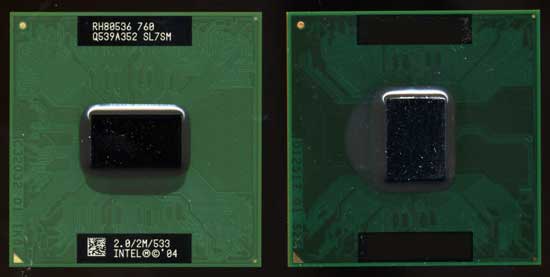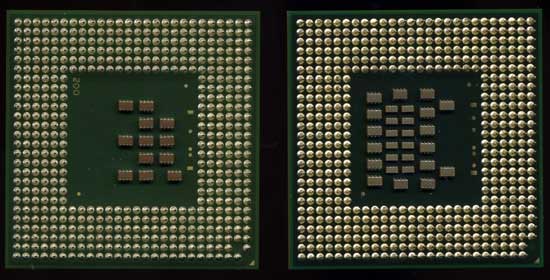Intel Core Duo (Yonah) Performance Preview - Part II
by Anand Lal Shimpi on December 19, 2005 12:55 PM EST- Posted in
- CPUs
It's called the Core Duo
When Yonah first started appearing on roadmaps, we knew it as Jonah, which then starting being written as Yonah. Eventually, Intel confirmed its existence and we had always assumed that it would continue to use the name Pentium M. However, given the great importance of the launch of Intel's first dual-core, low power, notebook processor, it shouldn't be much of a surprise that Intel has a new name in store for it. As you've probably already heard, Yonah will receive the marketing name "Core" with the words "Duo" or "Solo" following it depending on whether it is the dual or single core version. The name Centrino will still be there, but instead of referring to the processor as a Pentium M, it'll be called a Core Duo or a Core Solo. The Centrino platform itself will be referred to as Centrino Duo when paired with a Core Duo processor. We have to admit, we kind of like the new name.
Not so pleasant, however, are the new processor numbers that go along with the new processor names. Gone are Intel's simple three-digit numbers and they have since been replaced with a four-digit number preceded by a letter. The letter indicates the thermal envelope of the processor, while the following four digits denote the performance level of the CPU. If you think that this sounds oddly similar to AMD's Turion processor nomenclature, don't worry; you'd be completely right (of course, the Turion only uses two numbers, while Core Duo uses four). Maybe, one of these days, Intel will get around to copying some more important elements of AMD's history, such as an on-die memory controller or at least a serial bus interface.
As an example of the numbers in use, the 2.0GHz processor that we previewed in the first article will be sold under the name "Intel Core Duo T2500". For your reference, the T2600 will run at 2.16GHz (compared to the 2.0GHz T2500). The Core Solo processors will feature a "1" after the "T" denoting a single core; for example, the Intel Core Solo T1300 will run at 1.66GHz.
Intel's Core Duo and Solo processors both support a 667MHz FSB, which is enabled by the 945 chipset that Intel is pairing with them. The move to a 667MHz FSB is necessary, thanks to the increased bandwidth demands of a dual core processor.
As we mentioned in the first article, the Core Duo (and Solo) processors are not pin-compatible with the older Pentium M, even though they physically have the same number of pins.
When Yonah first started appearing on roadmaps, we knew it as Jonah, which then starting being written as Yonah. Eventually, Intel confirmed its existence and we had always assumed that it would continue to use the name Pentium M. However, given the great importance of the launch of Intel's first dual-core, low power, notebook processor, it shouldn't be much of a surprise that Intel has a new name in store for it. As you've probably already heard, Yonah will receive the marketing name "Core" with the words "Duo" or "Solo" following it depending on whether it is the dual or single core version. The name Centrino will still be there, but instead of referring to the processor as a Pentium M, it'll be called a Core Duo or a Core Solo. The Centrino platform itself will be referred to as Centrino Duo when paired with a Core Duo processor. We have to admit, we kind of like the new name.
Not so pleasant, however, are the new processor numbers that go along with the new processor names. Gone are Intel's simple three-digit numbers and they have since been replaced with a four-digit number preceded by a letter. The letter indicates the thermal envelope of the processor, while the following four digits denote the performance level of the CPU. If you think that this sounds oddly similar to AMD's Turion processor nomenclature, don't worry; you'd be completely right (of course, the Turion only uses two numbers, while Core Duo uses four). Maybe, one of these days, Intel will get around to copying some more important elements of AMD's history, such as an on-die memory controller or at least a serial bus interface.
As an example of the numbers in use, the 2.0GHz processor that we previewed in the first article will be sold under the name "Intel Core Duo T2500". For your reference, the T2600 will run at 2.16GHz (compared to the 2.0GHz T2500). The Core Solo processors will feature a "1" after the "T" denoting a single core; for example, the Intel Core Solo T1300 will run at 1.66GHz.
Intel's Core Duo and Solo processors both support a 667MHz FSB, which is enabled by the 945 chipset that Intel is pairing with them. The move to a 667MHz FSB is necessary, thanks to the increased bandwidth demands of a dual core processor.
As we mentioned in the first article, the Core Duo (and Solo) processors are not pin-compatible with the older Pentium M, even though they physically have the same number of pins.

Dothan (Pentium M) on the left, Yonah (Core Duo) on the Right

Dothan (Pentium M) on the left, Yonah (Core Duo) on the Right










103 Comments
View All Comments
vailr - Monday, December 19, 2005 - link
Re: Chipset Drivers used in the review:nForce4 6.66
Intel 7.0.0.25
Check here: http://www.fdrsoft.fr.fm/">http://www.fdrsoft.fr.fm/
Intel Version 7.2.2.1006
nForce4 Version 6.70
Marlin1975 - Monday, December 19, 2005 - link
Being that DVD shrink will not be updated anymore and the creator is now part of Nero, and the Recode program. Why not use Recode?PrinceGaz - Tuesday, December 20, 2005 - link
Personally I wouldn't touch any of the compressed domain transcoders like DVD Shrink as they sacrifice quality for speed. Something like DVD Rebuilder combined with the excellent CCE SP encoder provide the best possible quality and are just as easy to use as DVD Shrink. It's nowhere near as fast as DVD Shrink, but I'll take better picture quality over saving a few minutes any day.mrred - Monday, December 19, 2005 - link
Anyone else notice that the game benches seem horribly gpu-bound? How about giving us some lower resolutions in testing?Look at FEAR in particular: X2-4200 and X2-3800 getting exactly the same score? HELLO?!?!?!? That's not a cpu-benchmark. Gimme a break.
Anemone - Tuesday, December 20, 2005 - link
Frankly I appreciate testing that shows resolutions we actually play at. Now if only we'd see 1920x1200 :)blackbrrd - Monday, December 19, 2005 - link
The games are benchmarked at 1024x768.Personally I haven't played a game below 1024x768 since I got my GF2mx four or five years ago.
Most games look horrible below 1024x768, except the games ported from consoles ;)
saratoga - Monday, December 19, 2005 - link
Yeah and above 1024 you're GPU limited. Its almost like this was a CPU review.tfranzese - Monday, December 19, 2005 - link
That's not the point. The point is to relieve the GPU so regardless of what GPUs come out a year or two from now that alieviate this bottleneck we'll have known beforehand how the CPU handles things.Further, this is a CPU preview and as such we don't care about system performance or GPU performance; that shouldn't be the focus or included in the article. Instead, every benchmark should serve the articles purpose of comparing the CPUs - GPU bound benchmarks do NOT serve that purpose and should have their resolution lowered to serve that purpose, otherwise they should not be included because what point do they serve except fluff?
tayhimself - Monday, December 19, 2005 - link
Yeah this review is horrible, just like the first Yonah review.uop - Monday, December 19, 2005 - link
I wouldn't call it horrible.There are some weak points, but it does give a good idea about how the Core Duo performs.
Mainly:
- It's not as good as the A64 when it comes to games
- FP is much improved but not there yet
The article does do a good job of reminding us that Yonah is just the dress rehersal for the real deal. Conroe is supposed to be faster, wider, and full of 64-bit goodness. Think about it - with Yonah's die size, it could be the Celeron-M in just 6 months!
If Yonah can compete with the A64, then unless AMD pull a fast one they're probably heading for the underdog position.